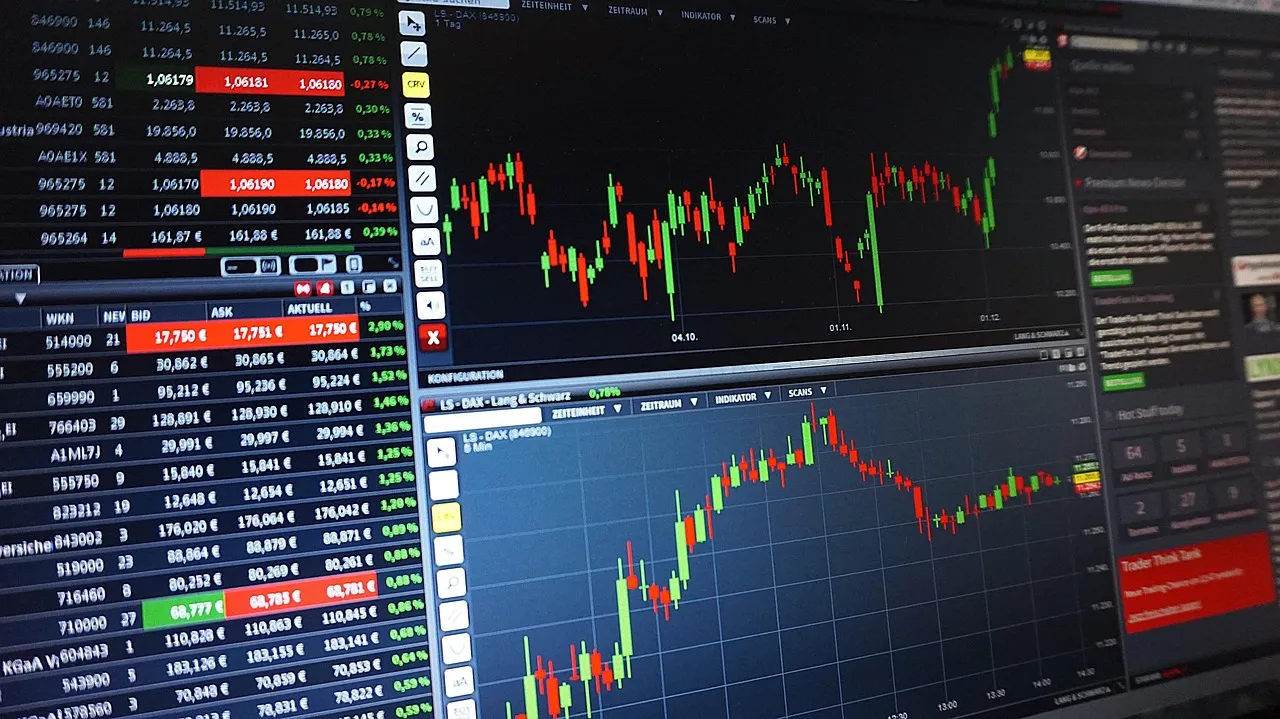In 2025, stock market automation has moved beyond hedge funds and is now a mainstream strategy for everyday investors. Thanks to the rise of AI trading bots, robo-advisors, and automated investing platforms, anyone with a smartphone and internet connection can now access tools once reserved for Wall Street.
The integration of artificial intelligence, machine learning, and algorithmic trading software has transformed how individuals analyze financial data, execute trades, and rebalance portfolios—all without the emotional bias or high fees of traditional advisors.
With just a few taps, investors can diversify portfolios, optimize returns, and build passive income using secure robo-advisors and low-fee investment platforms. From dividend reinvestment plans (DRIPs) to AI-powered portfolio management, modern tools allow you to invest smarter, faster, and with minimal effort. The days of manually tracking charts are gone—today, high-frequency trading bots and smart investing strategies do the heavy lifting, helping you grow your wealth on autopilot.

Why Automated Investing Matters in 2025
In today’s fast-paced financial landscape, automated investing has become more than a convenience—it’s a necessity. Amidst growing market volatility, rising inflation rates, and global economic uncertainty, investors are turning to AI-driven, data-backed strategies that eliminate human error and emotional bias.
By leveraging automated investment platforms, individuals can now:
- Reduce emotional bias and make consistent, logic-based decisions
- Respond to real-time market movements using intelligent algorithms
- Lower investment fees by avoiding expensive brokers and advisors
- Build passive income through smart portfolio rebalancing and compound growth
Whether you’re a working professional with limited time, a retiree seeking financial stability, or a beginner investor exploring low-risk options, stock market automation levels the playing field. It gives everyday investors access to the kind of institutional-grade investment tools once reserved for wealth managers and hedge funds—at a fraction of the cost.
Best AI-Powered Stock Trading Bots in 2025
In 2025, AI-powered trading bots are revolutionizing how everyday investors approach the stock market. These advanced software systems leverage machine learning algorithms, natural language processing (NLP), and real-time data analysis to execute trades with precision and speed—often outperforming human traders in both speed and consistency.
Whether you’re a passive investor looking to automate your portfolio or an active trader searching for alpha, the right AI bot can help you maximize returns, minimize emotional decision-making, and streamline your trading strategy.

Top 5 AI Stock Trading Bots to Watch in 2025
Here’s a comparison of the most powerful, user-friendly, and effective AI stock trading bots dominating the market this year:
| Bot Name | Key Features | Pricing (Monthly) | Best For |
| TradeGPT Pro | NLP-powered market sentiment analysis, risk management | $49 | Beginners & professional traders |
| AlgoMind | Deep learning asset rebalancing, long-term optimization | $79 | Long-term, passive investors |
| QuantumTrade | Microsecond execution, scalping strategies, custom AI | $99 | High-frequency & day traders |
| Zignaly AI | Copy-trading with AI-based trader scoring & risk profiles | Freemium | Passive users, hands-free trading |
| Pionex Ultra | AI-tuned grid bots, crypto + stock hybrid automation | $25 | Multi-asset & crypto investors |
Robo-Advisors vs. Human Financial Planners: ROI Comparison
As we enter a tech-driven era of investing, one of the most important decisions modern investors face is choosing between robo-advisors and traditional human financial planners. Each offers a distinct approach to portfolio management, but when it comes to returns on investment (ROI), fees, and accessibility, robo-advisors are quickly becoming the go-to choice for the average investor.
What Are Robo-Advisors?
Robo-advisors are automated, algorithm-based financial platforms that build and manage investment portfolios using data inputs like:
- Risk tolerance
- Investment timeline
- Income and retirement goals
They utilize modern portfolio theory (MPT) and automated rebalancing to help users stay aligned with their objectives—without emotional interference.
ROI Comparison: Robo-Advisors vs. Human Financial Planners
To help you decide, here’s a side-by-side breakdown comparing key performance factors of robo-advisors and human financial planners:
| Feature | Robo-Advisors | Human Financial Planners |
| Average ROI (Annual) | 6% – 8% (net of fees) | 5% – 9% (varies by skill, often higher fees) |
| Management Fees | 0.25% – 0.5% (flat, transparent) | 1% – 2% (may include hidden commissions) |
| Accessibility | 24/7 via mobile apps and web dashboards | Limited to office hours and appointments |
| Emotional Bias | None – fully algorithm-driven | Possible – human emotions may affect advice |
| Minimum Investment | As low as $10 | Often $100,000 or more |
Building Passive Income with Automated Investing
One of the most powerful financial goals for today’s investors is to create passive income—money that comes in without constant time or effort. Thanks to the rise of stock market automation, it’s now easier than ever to generate consistent income streams using robo-advisors, AI-driven platforms, and smart investing strategies that work 24/7 on your behalf.
Whether you’re planning for early retirement, a side income, or simply want your money to work harder, these automated investing tools can help you earn while you sleep.
Why Use Automation for Passive Income?
Traditional investing often requires ongoing research, active trading, and constant monitoring. Automation solves that by:
- Removing the emotional guesswork
- Enabling smart, rules-based investment behavior
- Reinvesting earnings automatically
- Operating 24/7—no office hours, no sleep needed

Proven Automated Strategies for Passive Income
Here are some of the most reliable and scalable strategies for building passive income using automated investing tools in 2025:
1. Dividend Investing with AI Tools
Dividend-paying stocks are one of the most reliable ways to earn passive income. Platforms like M1 Finance, Wealthfront, and Fidelity Go allow you to:
- Automatically reinvest dividends using DRIP (Dividend Reinvestment Plans)
- Use AI filters to choose high-yield dividend stocks
- Track performance and risk using smart dashboards
Example: Let’s say you invest $10,000 in a portfolio yielding 4% annually. Through auto-reinvestment, your portfolio will grow faster without you lifting a finger—thanks to compounding.
2. Index Fund Allocation via Robo-Advisors
Index funds, especially ETFs (Exchange-Traded Funds), offer low-cost exposure to a broad market. Robo-advisors like Betterment, SoFi Invest, and Vanguard Digital Advisor automate this entire process:
- Allocate funds across diverse sectors
- Track benchmark indices (S&P 500, Nasdaq, etc.)
- Automatically rebalance your portfolio based on market movements
This “set-it-and-forget-it” strategy is ideal for consistent, long-term income growth.
3. Recurring Deposits + Auto-Rebalancing
This is one of the simplest yet most effective automated wealth-building tactics. Here’s how it works:
- Set automatic deposits weekly or monthly from your bank account
- Robo-advisors invest those funds according to your goals
- Your portfolio is automatically rebalanced to maintain the ideal asset allocation
This method leverages dollar-cost averaging—minimizing the risk of market timing and maximizing your passive returns over time.
4. AI Trading Bots with Set Strategies
AI trading bots are perfect for active-passive hybrids who want automated income with more trading intensity. Platforms like Pionex, TradeGPT Pro, and Zignaly allow you to:
- Configure bots based on RSI, MACD, moving averages, or momentum trading
- Set risk limits, stop-loss orders, and take-profit targets
- Let your bots trade 24/7, even while you’re asleep
This is best for those who want a more aggressive approach to automated income while minimizing emotional decision-making.
Passive Income Doesn’t Mean Passive Planning
While automated investing platforms do the heavy lifting, successful passive income still requires:
- Choosing the right platforms with low fees
- Setting realistic return expectations
- Periodically reviewing your goals and adjusting strategies
Once set up, these systems offer a predictable and scalable way to grow your wealth without daily effort.
Security & Risk Management in Automated Investing
While automated investing offers unparalleled convenience and efficiency, security remains a paramount concern for investors. Given the automated nature of these platforms, it’s essential to understand how to protect your investments from potential threats such as hackers, fraudulent activities, and market volatility.
The key to secure, stress-free investing lies in selecting SEC-registered robo-advisors, FINRA-compliant trading bots, and implementing strong personal security measures.
How to Ensure Safe and Secure Automated Investing
When diving into the world of AI-powered trading bots and robo-advisors, you’ll want to make sure that your chosen platform meets stringent security standards. Here are some vital steps you can take to ensure your investments are well protected:
1. Choose SEC-Registered Robo-Advisors or FINRA-Compliant Trading Bots
The first step in securing your investments is to use platforms that adhere to regulatory standards. These standards ensure that the platform follows strict protocols regarding:
- Fund security
- Transparent fee structures
- Data protection policies
Robo-advisors like Betterment, Wealthfront, and Vanguard Digital Advisor are SEC-registered and follow these protocols to ensure safe operations. Similarly, many AI trading bots integrate with regulated brokers like TD Ameritrade or Interactive Brokers, which are FINRA-compliant.
2. Enable Two-Factor Authentication (2FA)
Two-factor authentication (2FA) adds an extra layer of security by requiring you to provide two forms of identification before accessing your account:
- Something you know (your password)
- Something you have (a phone or hardware device)
By enabling 2FA on your trading or investing accounts, you dramatically reduce the chances of unauthorized access, even if your login credentials are compromised. This is essential for protecting your robo-advisor accounts and AI trading bot accounts.
3. Use Cold Wallet Storage for Crypto-Involved Bots
If you’re using crypto-integrated trading bots or investing in cryptocurrency portfolios, it’s crucial to secure your assets by using cold wallets for storage.
- Cold wallets (offline storage) protect your assets from online threats like hacking.
- Store your private keys and crypto holdings in hardware wallets such as Ledger or Trezor.
By choosing crypto bots that support cold wallet integration, such as Pionex or 3Commas, you can ensure that your assets are offline and safe from hackers.
4. Set Stop-Loss and Risk-Limit Parameters
To minimize potential losses in volatile markets, ensure that your trading bots or robo-advisors have built-in stop-loss and risk-limit functionalities:
- Stop-loss orders automatically sell an asset if its price drops below a specified threshold, ensuring you don’t suffer from deep losses.
- Risk-limit parameters help ensure your bot doesn’t trade outside of predefined risk tolerance levels.
By configuring these safeguards, you protect your portfolio from market crashes and unexpected downturns, while allowing your bot to execute trades within your risk boundaries.
5. Monitor Account Activity Regularly
Though automation offers convenience, regular monitoring of your investment accounts ensures everything is running smoothly. Key activities to monitor include:
- Checking for unauthorized transactions
- Reviewing performance metrics
- Updating your security settings as needed
Many AI platforms provide real-time alerts and performance tracking so you can easily keep an eye on your automated portfolio.
6. Stay Informed About Cybersecurity Threats
The cybersecurity landscape is constantly evolving. Stay informed about the latest threats, such as phishing attacks, malware, and social engineering scams, to protect your personal information and assets.
Many robo-advisor platforms and trading bot services offer regular security updates and guidelines to help you stay ahead of new risks.
Final Thoughts: Should You Trust Automation with Your Portfolio?
In 2025, automated investing is smarter, faster, and more accessible than ever. Powered by AI and machine learning, robo-advisors and trading bots help investors save time, reduce fees, and avoid emotional mistakes. Whether you’re building passive income or simply want to grow your wealth efficiently, automation offers scalable tools to reach your financial goals with minimal effort. From dividend reinvestment to algorithmic trading, the benefits are real—and growing.

FAQs: Stock Market Automation & Robo-Advisors
To wrap up, here are some frequently asked questions investors often have about using robo-advisors and AI trading bots in 2025:
Q1. Are robo-advisors safe in 2025?
Yes. Most top robo-advisors—such as Betterment, Wealthfront, and Fidelity Go—are SEC-registered, use bank-level encryption, and offer SIPC insurance on your investment accounts. They also follow strict compliance protocols and provide two-factor authentication (2FA) for added security.
Q2. Can AI trading bots guarantee profits?
No. Even the best AI trading bots—like TradeGPT Pro or Zignaly AI—use historical data and predictive modeling, but markets remain unpredictable. These bots increase your chances of profitable trades but cannot eliminate risk. Always use stop-loss limits and follow proper risk management.
Q3. What’s the minimum investment for robo-advisors?
Many robo-advisors have low minimums, making them perfect for beginners. Some platforms, like SoFi Invest and Acorns, allow you to start with just $10–$100.
